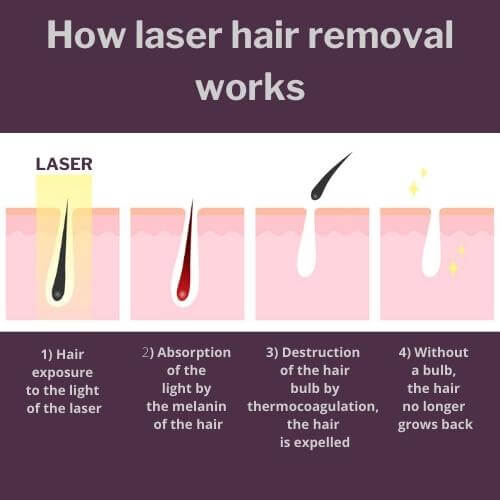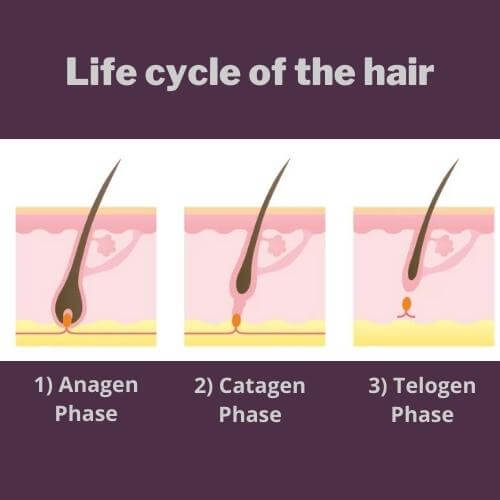Once reserved for light skin types with dark hair, laser hair removal is attracting more and more interest. This is particularly true for more pigmented skin types that were not originally advised to undergo this type of hair removal.
Over the past ten years, new technological advances have been made. Today, it is possible to treat all skin phototypes with a laser and a wavelength adapted to them.
Although this process raises a lot of questions, more and more people with black, matte and mixed skin are opting for this permanent solution. Indeed, many women get lost in choosing the best hair removal method for their skin type.
This is where laser hair removal becomes interesting because, in addition to removing hair, it can also get rid of ingrown hairs that often cause hyperpigmentation spots.
Between the particularities, functioning, contraindications and recommendations, this article is designed to shed light on everything you need to know about laser hair removal for black, dark and mixed-race skin.
Is laser hair removal for pigmented skin possible?
Yes, laser hair removal is a technique for permanently removing dark hair.
 Among the different skin colors, there is a very wide variety of shades, from the lightest to the most pigmented. Taking this diversity into account, a classification allows us to group these skin types into 6 phototypes. This is the Fitzpatrick classification.
Among the different skin colors, there is a very wide variety of shades, from the lightest to the most pigmented. Taking this diversity into account, a classification allows us to group these skin types into 6 phototypes. This is the Fitzpatrick classification.
Before each permanent laser hair removal treatment, the practitioner takes the time to determine the patient's skin tone according to this classification. He will also determine the color of the hair in order to correctly set up the laser.
Thus, thanks to this analysis of the skin beforehand, it is now possible to remove hair with the laser from any skin color.
How laser hair removal works on black, matte or mixed skin
Laser hair removal consists in sending a laser beam of a precise wavelength onto the skin surface.
Hair removal on fair skin
Initially, depilatory lasers were based solely on the wavelength absorbed by melanin. This was the case with the Alexandrite laser (755 nm), recommended for light skin with dark hair.
Indeed, this wavelength is specific to the melanin in the hair, which gives it its black coloring. This is why, if the hair is not dark but rather blond, white or red, laser hair removal is almost ineffective.
When the skin is light (very low in melanin) with dark hair (high in melanin), the light beam is absorbed by the melanin contained in the root of the hair. Once absorbed, it is transformed into heat that can exceed 150°C (cell coagulation threshold). It is this heat that burns the hair at the root and allows it to be permanently destroyed.

Hair removal on black, brown and mixed-race skin
On the other hand, on melanin-laden skin (tanned, dark or black skin), using the same type of laser is more risky. Indeed, the beam can confuse the melanin of the skin with that of the hair.
The consequence could then be a burning of the epidermis instead of the hair and lead to complications such as inflammation, scars, hyperpigmentation spots, etc.
To avoid this, laser hair removal technologies have evolved and been perfected in response to the high demand from people of all phototypes or people with a tan in the summer.
For phototypes IV, V and VI, corresponding to black, dark and mixed-race skin, the use of a specific laser is necessary. It is a YAG laser that targets the hair and does not damage the skin.
Its name, Nd:YAG (for neodymium-doped yttrium aluminum garnet), comes from the component of the crystal that is the "source" of the laser. Its wavelength (1064nm) allows this time an action on the deeper layers of the skin. These layers being less loaded with melanin, the laser can act more on the nourishing structures of the hair bulb than on the melanin. This makes it possible to respect the skin of more pigmented people and to remove hair with the laser without risk.
Clinical reactions of fair skin and pigmented skin after laser hair removal
There are some differences between these two types of laser, especially in the clinical reactions that patients may experience during and after the session.
During an Alexandrite laser hair removal session, it is common to hear small dry clicks when the laser is in contact with the hair and to see the hair expelled during the session. Follicular edemas (small temporary blisters) may or may not appear on the skin a few minutes later.
Finally, the hair destroyed by the laser is expelled by the skin for 1 to 2 weeks.
During an Nd:YAG laser hair removal session, there is no popping, follicular edema is rare, and hair expulsion is progressive and may give the impression that it is still growing.
Generally with this type of laser it is necessary to do more sessions than with an Alexandrite laser because on the finest hairs it is sometimes a little less effective.
However, repeating the number of sessions is essential regardless of the type of laser. This is due to the life cycle of the hair which contains 3 stages:
- Anagen phase: The hair has just grown. It is fed by the vascular system and remains attached to the bulb.
- Catagen phase: The hair starts to detach from the bulb and stops growing.
- Telogen phase: The hair is completely detached and is expelled by the new hair that arrives.

The purpose of the laser is to transform the laser beam into heat to destroy the nourishing structures of the hair. Consequently, only hairs in the anagen phase (phase 1) will be reached by the pulsed light since they are the only ones well attached to the bulb.
Not all hairs have the same growth rate, so it will be necessary to do several sessions to reach all of them at the right time.
Course of a laser hair removal session
Medical visit
To safely remove hair from pigmented skin with a laser, it is very important to choose a medical center specialized in the field and equipped with an Nd:YAG laser.
A first appointment with a specialist doctor allows for an analysis of the general state of health, the type of skin and the hairiness. A laser test on a small area can also be proposed to verify that the skin reacts well and thus limit the risks (hyperpigmentation spots, depigmentation, etc.). The type of laser will be chosen after this medical visit and an estimate can be established.
Before the session
It is important not to pull out the hair bulb.
For this reason, no wax, depilatory cream or any other depilatory product should be used on the area to be treated in the 30 days preceding the first session.
However, it may be necessary to shave the area to be depilated a few days before the session (especially for the legs, underarms and bikini area).
During the session
The area to be depilated will be cleaned and dried beforehand. A session of 15 to 30 minutes follows, depending on the hairiness of the area.
Wearing eye protection is essential for the doctor as well as for the patient in order to protect themselves from the laser beams. The same is true for moles, tattoos and sometimes even teeth, which must also be protected.
At the end of the treatment, the doctor applies a special cream to relieve and soothe the skin, which can sometimes become a little marked at the end of the session.
Number of sessions
In the case of black, dark and mixed skins, the hair takes a little longer to fall out: it is generally necessary to wait until 2 or 3 sessions to see the first results.
All sessions should be spaced 4 to 6 weeks apart. And generally, for a lasting result, it is necessary to multiply the number of sessions: 5 to 10 depending on the hairiness of the area to be removed.
Price of sessions
The first laser hair removal consultation (medical visit) is generally free. The price then depends on the area to be depilated and not on the patient's phototype.

Contraindications and recommendations for safe laser hair removal without risk
It is recommended to inform the doctor - dermatologist of :
READ THE WHOLE ARTICLE
Add to favourites





